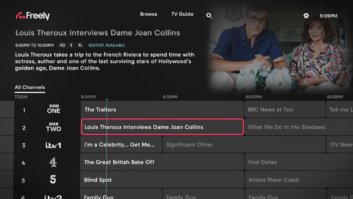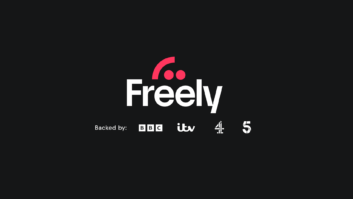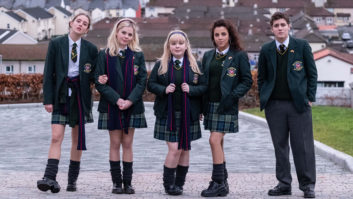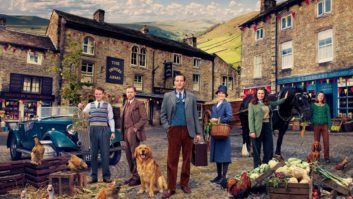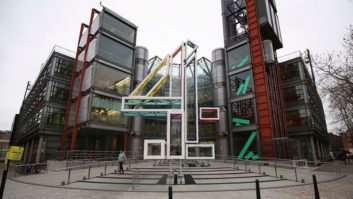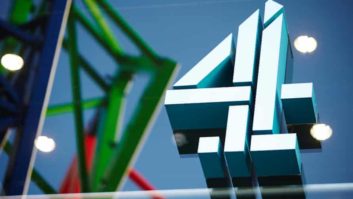Clear, in conjunction with Red Bee Media, has just completed a gargantuan project for the UK’s BBC 2, in the form of six differently-themed set of channel idents, including many multiple versions and over 450 masters. The complex brief required many weeks of intense 2D and 3D post production, plus intricate project management involving four separate directors, writes Andy Stout.
The idents are broad in their subject matters, ranging from cappuccinos to a police chase, but are united by ‘masks’ in the shape of a number 2 – the instantly identifiable BBC 2 logo. For example, we see a man evading the police in a forest chase by hiding in a 2-shaped cave; a car sunroof provides a 2-shaped view of the moving sky above; cocoa is shaken over a cappuccino using a cut-out to form a neat chocolate ‘2’. Other idents follow the theme using car journeys, zoetropes, seascapes, art galleries and tents.
Each ident has its own distinct style, hence the wide selection of directors used for the project. As such, it follows that each has a unique set of post production requirements. Here are three examples.
The three ‘Tent’ idents cleverly incorporate BBC 2’s logo as a zippered door. In ‘Festival’, the tent door is unzipped to reveal a scene from a music festival. In ‘Explorer’ the door is opened to unveil an Everest-style adventure, and ‘Beach’ is fairly self-explanatory. The tent, with its 2-shaped door, was made by a specially-commissioned seamstress and shot in a studio. The zip’s details were enhanced by re-building it in 3D to make it more visible. The 3D team then recreated the studio-shoot camera move and tweaked the camera moves until the 2-shaped door concept was fully apparent. Shadow detail was mostly taken from the studio shoot but, again, was enhanced in 3D and projected back over the tents to really bring the sequences to life. The backgrounds in ‘Explorer’ and ‘Festival’ were taken from hi-res stills. To make these scenes seem more dynamic, bluescreen-shot people, perspective and movements were added alongside some re-grading and re-lighting, to successfully convey the interactive lighting from a campfire, for example. In ‘Festival’, the grass was graded using 2D and 3D techniques within a 3D lighting environment to authentically recreate sunlight and its interaction with the tent. In total, this set of idents alone took a team of four 3D artists working solidly for two weeks, after which it required a further week in Flame.
‘Mirror’ incorporates the BBC 2 logo as a car wing mirror. The ident opens as a water droplet hits the wing mirror of a fast-moving car. As the drop slides down the mirror, the camera pulls back to reveal a lo-fi stylised car travelling through some quiet streets. The initial water droplet was shot in camera. After being enhanced in Flame with lens flares, highlights and new reflections, it was tracked onto the wing mirror. Foreground and reflection mirror footage were captured from a camera car and composited together with the motion-controlled car passes, which were shot in a greenscreen studio. This ident required up to 28 HD layers, each one representing various elements such as shadows, reflections, floors, grit layers, motion blur camera flares, glints, beauty passes and so on.
‘Seascape’ shows the ocean crashing through a ‘2’-shaped mask made out of wooden planks. The surf was shot for real and augmented in Flame, by grabbing areas of swell and re-matting them to accentuate the turbulence. The wooden mask was shot in situ, then extended and camera-mapped in CG to the edges of frame. A perfect 3D camera track was crucial to pulling this off convincingly. Once this track had been cracked, hi-res textures were created, sourced from digital stills and the plates, to blend the real planks with the digitally created planks. The 3D team also added details such as barnacle textures, created gaps of light in between the uneven planks and created a perspective change in accordance with the camera’s pullback. The ocean footage and the 3D plank mask were then combined in Flame, blending and animating the water over the base line of the plank mask by combining 3D and 2D techniques.
